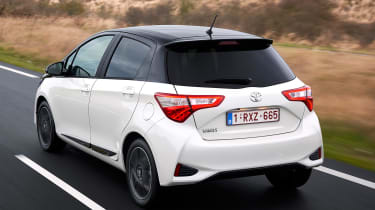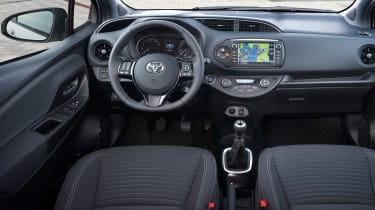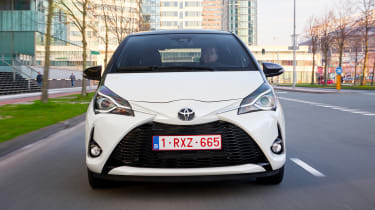New Toyota Yaris 2017 review
The Toyota Yaris has been updated for 2017, but are the changes enough for it to stand out in the supermini class?

The fight to top the supermini class is in full swing, with the new Nissan Micra impressing and VW Polo still a strong contender, but sadly this updated Toyota Yaris isn’t complete enough to challenge the best. It retains its best qualities, namely being comfortable, reasonably spacious and handsome – not forgetting the five-year warranty. However this iteration of the Yaris was launched back in 2011 and while it’s more up-to-date it doesn’t feel like a truly modern car.
The Toyota Yaris is one of the brand’s best-selling models, and in the UK it competes with the hugely popular Ford Fiesta, Vauxhall Corsa and VW Polo models in the supermini class. It’s easy to see why Toyota has refreshed the car with this new facelifted version, then.
It’s a subtle change, but the new front end is sportier than before, drawing inspiration from the current World Rally Championship Yaris with its new grille and headlights. The rear has been overhauled, though, with a completely new boot door and updated lights.
The Yaris was already a handsome little hatchback, and the changes have built upon that. It’s certainly more interesting to look at than a Polo, just like the other two Japanese superminis that have launched: the Nissan Micra and the Suzuki Swift. It’s five-door only, however, and doesn’t have the quirky looks of the (admittedly more expensive) Fiat 500 or MINI.
Used - available now

2025 Toyota
Yaris
23,835 milesAutomaticPetrol1.5L
Cash £15,406
2025 Toyota
Yaris
12,538 milesAutomaticPetrol1.5L
Cash £16,087
2020 Toyota
Yaris
26,591 milesAutomaticPetrol1.5L
Cash £13,406
2020 Toyota
Yaris
38,351 milesManualPetrol1.0L
Cash £10,087• Best superminis on sale right now
Toyota has also updated the interior with some new materials, although the design is very similar to the previous car. It’s available in some new colours including blue and red, but overall it still lags behind the competition.
It feels well built, but the scratchy plastics and ugly-looking materials mean it feels like a car from years ago. The VW Polo and even the Micra feel much more modern inside, and have much better infotainment screens as well - the Yaris’ seven-inch Toyota Touch 2 display is hard to see and use from the driver’s seat. The additional features such as Google Street View and Wi-Fi are useful, though.
There’s a new 4.2-inch TFT display between the dials, which looks good and has plenty of useful driving information. It’s just not enough for the Yaris’ interior to stand out from the crowd in a class with so many talented rivals.
The biggest addition to the car is arguably the new 1.5-litre petrol engine, which replaces the old 1.33-litre unit. It’s much more useable than the old engine - while the car is still lacking the torquey power delivery of its turbocharged rivals, the new engine doesn’t feel underpowered like it did before.
You need to work the engine hard to get the most out of it, but it’s actually fun to do that thanks to the surprisingly sporty-sounding exhaust note. The six-speed manual is decent too, but a Mazda 2 feels much more lively - its engine is sweeter and the gear change is slicker.
Economy of 58.9mpg is a small improvement over the old car, and while a VW Polo 1.2 TSI claims 62.8mpg, we expect the Toyota’s naturally-aspirated unit will get closer to the claimed figure in the real world. However the 1.2 TSI engine’s punchy feel means it feels much more grown-up - and it’s a lot faster despite having the same power output. The Polo takes 9.3 seconds to get from 0-62mph, while the Yaris takes 11 seconds.
Toyota says there have been improvements when it comes to dynamics, but the Yaris still feels set up for comfort more than anything, with light steering and lots of body movement through corners. Sadly the arrow-straight, smooth roads on our test route in the Netherlands meant we weren’t able to test the ride and handling fully, although it did feel comfortable over some fairly harsh speed bumps around town.
The changes haven’t affected space inside the car, so there’s still a spacious 286-litre boot in the back - that’s six litres more than in a Polo, however, and the VW has more headroom for passengers in the back. Legroom is about equal between the two models, of course depending on the height of those up front.
All cars now get Toyota Safety Sense as standard, which adds a pre-collision system, lane departure warning and auto high beams. The Icon specification, a top-seller in the UK, adds some new 15-inch alloys and that 4.2-inch TFT screen behind the steering wheel, plus a 7-inch display on the dash and a reversing camera.
Road sign recognition is fitted too, but on our test route it frequently displayed speed limits that conflicted with both the sat-nav and the real road signs. Plus, the Yaris has been outdone by the new Micra, which gets automatic emergency braking and pedestrian recognition as standard in the UK.
In fact that’s the case in almost every area - the Yaris isn’t as fun to drive as a Fiesta, it’s not as refined as a VW Polo, it’s not as spacious as a Suzuki Baleno and it’s not as quirky as a Fiat 500.










